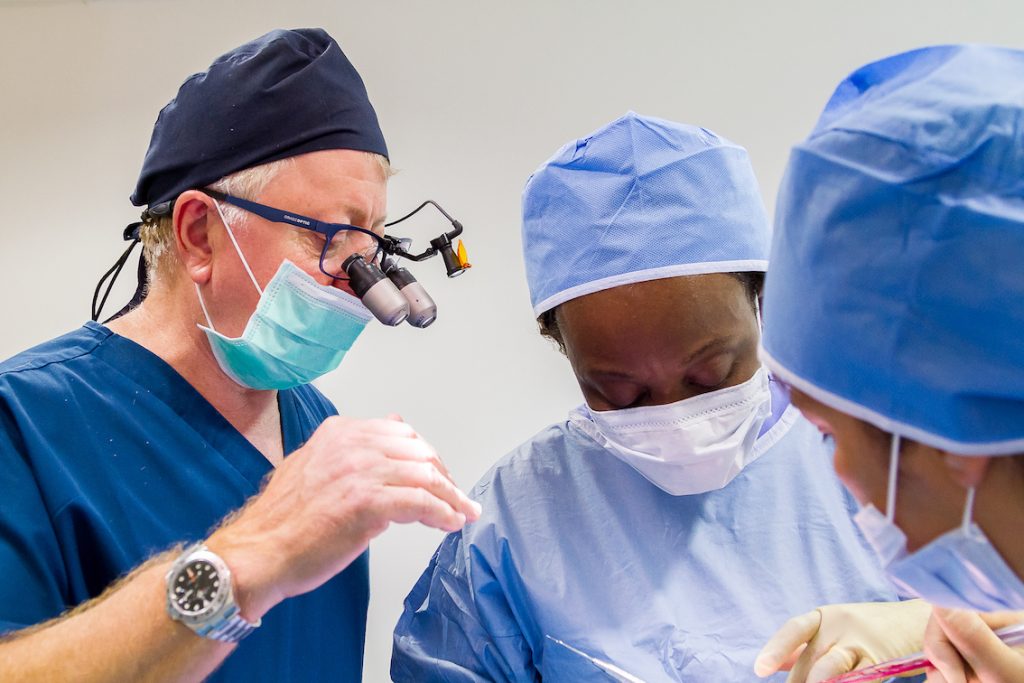Referrals – for peace of mind when you need it most
Featured Products Promotional FeaturesPosted by: Dental Design 27th July 2022

With many issues affecting the longevity of natural dentition, such as disease, trauma or certain health conditions, dental implants have become a life-changing solution for patients of all ages.
In recent years, researchers and developers have made remarkable improvements to the techniques, technologies and products in the field. Despite this, many clinicians will still encounter challenging cases. As with all dental treatments, the safety of the patient overrides all else, and as such the clinician will need to make the right decision for the health and happiness of their patients. One such decision includes referring patients to a specialist, which gives them peace of mind that their patient is receiving the most appropriate care for their needs.
Failed implant cases
Dental implant failure is certainly frustrating for the patient and the clinician alike. There are many circumstances that can lead to implant failure. Researchi has noted that early implant failures are mainly biological in nature, potentially caused by unsuccessful osseointegration, iatrogenic trauma or infection. Soft tissue complications can occur around dental implants, namely a lack of attached mucosa, deficient volume and peri-implant mucosal recession.[i] Mechanical causes of implant failure include implant fractures that occur due to fatigue and trauma, which require a complex, surgical extraction of the dental implant and its supporting bone.[ii] Damage to the abutment and abutment screw are also considered mechanical causes of dental implant failure.
One study found that the survival rate of dental implants, placed at sites where a previous implant had failed, is lower than generally reported.[iii] The clinician will need to balance the risk factors with the desires of the patient, as the issues that caused the original failure may also threaten the replacement restoration.[iv] If presented with a failed implant case, the clinician may consider referring if this is beyond their remit, to ensure the patient receives the highest standard of care.
Nerve damage
As nerve damage during treatment can cause neuropathic pain and discomfort for the patient, this surgical complication is highly undesirable and stringent steps must be followed for its prevention. Nerve damage can be caused by several situations, including injury from drilling, compression by the dental implant fixture, an abnormal mandibular nerve canal or hematoma.[v]
The importance of early diagnosis, and treatment, cannot be understated.[vi] As you well know, preventative measures are paramount to ensuring that nerve damage does not occur. For some cases, nerve lateralisation and repositioning may be clinically necessary to allow the placement of longer implants in the mandible. Indeed, research has noted that these complex surgical techniques may be the only possible procedure for patients seeking restorative care, but present with an atrophic posterior mandible.[vii]
Elderly and medically-compromised dental implant patients
Patients from a range of age brackets can undergo dental implant therapy and enjoy an aesthetic, functional dentition. Of course, vulnerable patients, such as the elderly and those who are medically-compromised, may be at a higher risk than other patient groups for complications.
Older patients may present with multimorbidity, frailty and polypharmacy; thus, their approach to care must be tailored to their situation to ensure clinical safety. Additionally, medical treatments such as radiotherapy may have an influence on the dental implant’s survival, with associations to a higher risk of halitosis.[viii] General aging also puts patients at risk of developing issues such as inflammation and periodontitis.[ix]
 Medically-compromised patients, such as those with systematic conditions like arthritis, cardiovascular diseases and neurologic disorders,[x] will likewise require individualised care. Clinical decisions and assessments must be made carefully with all patients, but especially those with increased health risks. Balancing the patient’s desires with considerations for their condition can be challenging; seeking guidance from a specialist can aid clinicians in delivering treatment that is tailored to the patient’s circumstances.
Medically-compromised patients, such as those with systematic conditions like arthritis, cardiovascular diseases and neurologic disorders,[x] will likewise require individualised care. Clinical decisions and assessments must be made carefully with all patients, but especially those with increased health risks. Balancing the patient’s desires with considerations for their condition can be challenging; seeking guidance from a specialist can aid clinicians in delivering treatment that is tailored to the patient’s circumstances.
Put your patient first
If a patient case falls outside of a clinician’s skill or experience, referring the patient to a specialist will ensure that they received the most appropriate care.
The Centre for Oral-Maxillofacial and Dental Implant Reconstruction ensures that all patients receive relevant and personalised care. Run by Dr Cemal Ucer, Specialist Oral Surgeon, the Centre provides a range of treatment options, all performed by highly-trained and competent professionals. These include day-care surgery for the elderly and medically compromised patients, the management of nerve damage/nerve lateralisation and the management and re-treatment of failing dental implants, among plenty more. With cutting-edge facilities and technologies, the Centre for Oral-Maxillofacial and Dental Implant Reconstruction provides the highest standards of patient care, with personal and individual attention.
By referring, clinicians are increasing the possibility for a successful treatment outcome, as well as prioritising the safety of their patients.
Please contact Professor Ucer at ucer@icedental.institute or Mel Hay at mel@mdic.co
01612 371842
www.ucer-clinic.dental
Author: Professor Cemal Ucer (BDS, MSc, PhD, Oral Surgeon, ITI Fellow)
[i] Thoma, D.S., Gil, A., Hämmerle, C.H.F. and Jung, R.E. (2022). Management and prevention of soft tissue complications in implant dentistry. Periodontology 2000, [online] 88(1), pp.116–129. Available at: https://onlinelibrary.wiley.com/doi/full/10.1111/prd.12415 [Accessed 19 May 2022].
[ii] Shemtov-Yona, K. and Rittel, D. (2015). An Overview of the Mechanical Integrity of Dental Implants. BioMed Research International, [online] 2015, pp.1–11. Available at: https://www.ncbi.nlm.nih.gov/pmc/articles/PMC4637045/ [Accessed 19 May 2022].
[iii] Oh, S.-L., Shiau, H.J. and Reynolds, M.A. (2020). Survival of dental implants at sites after implant failure: A systematic review. The Journal of Prosthetic Dentistry, [online] 123(1), pp.54–60. Available at: https://pubmed.ncbi.nlm.nih.gov/31027959/ [Accessed 19 May 2022].
[iv] Quaranta, A., Perrotti, V., Piattelli, A., Piemontese, M. and Procaccini, M. (2014). Implants Placed in Sites of Previously Failed Implants. Implant Dentistry, [online] 23(3), pp.311–318. Available at: https://journals.lww.com/implantdent/Fulltext/2014/06000/Implants_Placed_in_Sites_of_Previously_Failed.15.aspx [Accessed 19 May 2022].
[v] Fukuda, K., Ichinohe, T. and Kaneko, Y. (2012). Pain Management for Nerve Injury following Dental Implant Surgery at Tokyo Dental College Hospital. International Journal of Dentistry, [online] 2012, pp.1–9. Available at: https://www.hindawi.com/journals/ijd/2012/209474/ [Accessed 19 May 2022].
[vi] Shavit, I. and Juodzbalys, G. (2014). Inferior Alveolar Nerve Injuries Following Implant Placement – Importance of Early Diagnosis and Treatment: a Systematic Review. Journal of Oral and Maxillofacial Research, [online] 5(4). Available at: https://www.ncbi.nlm.nih.gov/pmc/articles/PMC4306320/ [Accessed 19 May 2022].
[vii] Abayev, B. and Juodzbalys, G. (2015). Inferior alveolar nerve lateralization and transposition for dental implant placement. Part I: a systematic review of surgical techniques. Journal of oral & maxillofacial research, [online] 6(1), p.e2. Available at: https://www.ncbi.nlm.nih.gov/pmc/articles/PMC4414233/ [Accessed 19 May 2022].
[viii] Maluf, G.V., Caldas, R.J., Fregnani, E.R., Antunes, H.S., Tobias, M.A.S. and da Silva Santos, P.S. (2022). Evaluation of halitosis parameters in patients undergoing head and neck radiotherapy. Oral Diseases. [online] Available at: https://pubmed.ncbi.nlm.nih.gov/35485180/#:~:text=Higher%20doses%20of%20radiation%20to [Accessed 19 May 2022].
[ix] Woelber, J.P. and Fretwurst, T. (2022). Patient-related risk factors for peri-implantitis and pre-implant treatment – Online DZZ. 01, [online] 01(347), pp.36–36. Available at: https://www.online-dzz.com/archive/issue/article/dzzint-1-2022/5797-1053180-dzz-int20220005-patient-related-risk-factors-for-peri-implantitis-and-pre-implant-tr/ [Accessed 19 May 2022].
[x] Ghimire, P., Suwal, P. and Basnet, B.B. (2022). Management of Medically Compromised Prosthodontic Patients. International Journal of Dentistry, [online] 2022, p.7510578. Available at: https://www.ncbi.nlm.nih.gov/pmc/articles/PMC8767402/ [Accessed 19 May 2022].








